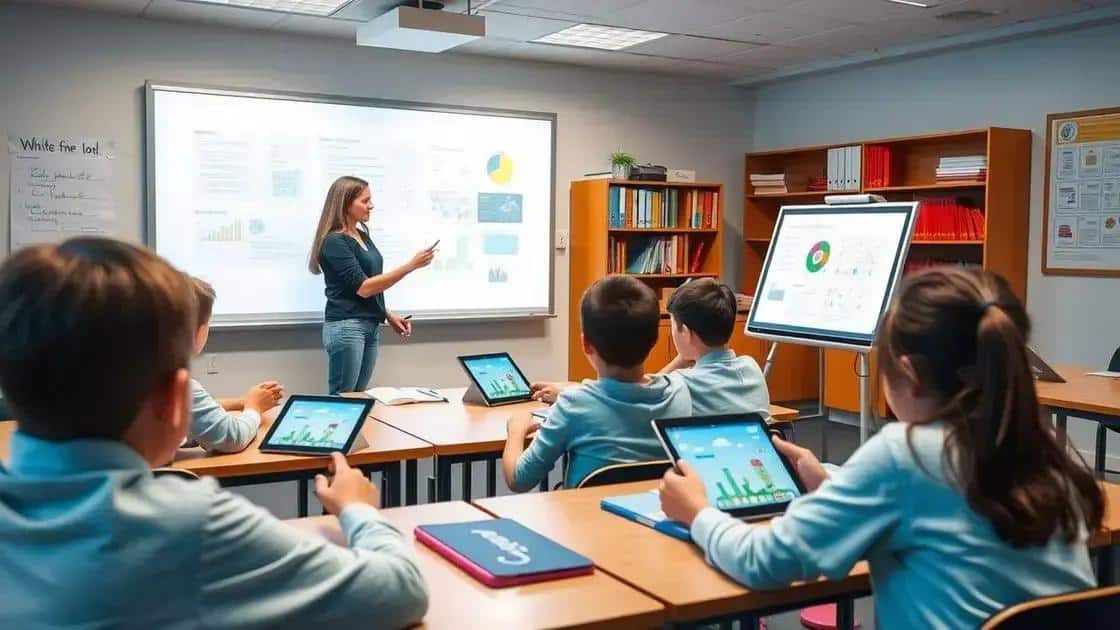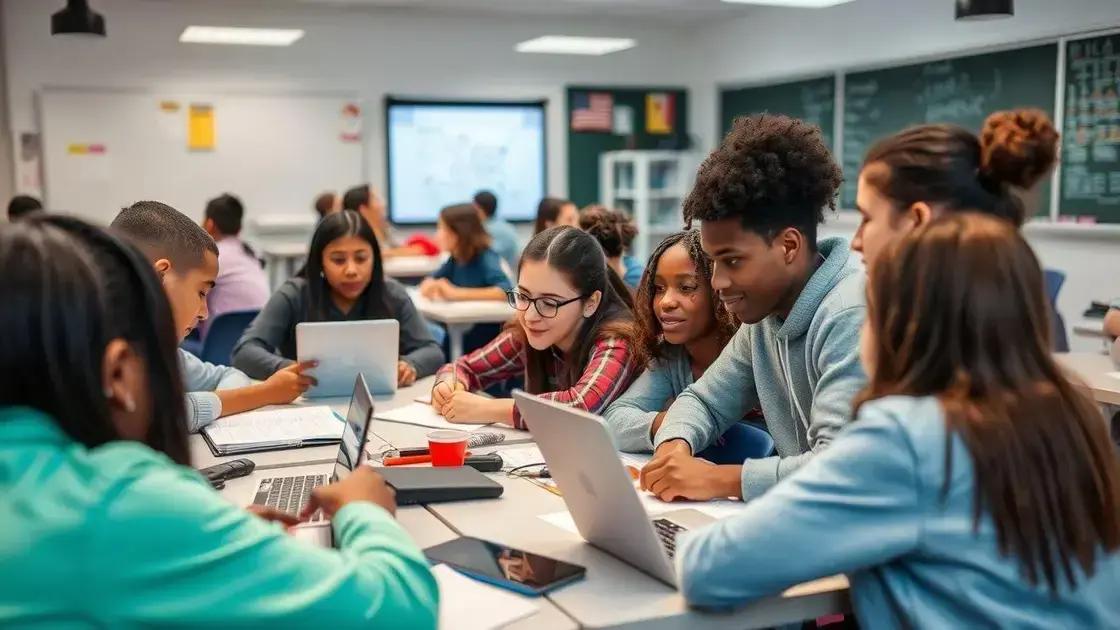Teacher workforce challenges: Analyzing tariff exemptions for iPhones

Anúncios
The future outlook for teachers in an evolving market emphasizes the importance of embracing technology, continuous professional development, and adaptability to meet new educational demands and improve student outcomes.
Teacher workforce challenges are becoming more complex as external factors like tariff exemptions for Chinese-made iPhones play a role in education. Have you considered how these developments might impact your teaching environment or resources?
Anúncios
Understanding current challenges in the teacher workforce
Understanding the current challenges in the teacher workforce is essential for creating solutions that benefit educators and students alike. Many factors contribute to these challenges, and recognizing them helps us address the issues effectively.
Key Issues Facing Teachers
Teachers today face various hurdles that can impact their effectiveness and job satisfaction. These issues range from resource limitations to administrative pressures. The following aspects are particularly significant:
Anúncios
- Salary Disparities: Many educators struggle with low salaries, which can lead to job dissatisfaction and high turnover rates.
- Workload Stress: The demands placed on teachers have increased over the years, leading to burnout and decreased morale.
- Technology Integration: Adapting to new educational technologies can be challenging, especially for those without adequate training.
- Student Needs: Addressing diverse student needs requires additional support, which is often lacking in many districts.
The environment in which teachers operate is constantly evolving, and as these challenges persist, finding innovative solutions becomes vital. Schools must prioritize mental health support and professional development opportunities to create a sustainable teaching culture.
Impact on Student Learning
The challenges faced by teachers have a direct impact on student learning outcomes. When teachers are overwhelmed, it can lead to less engaging instruction, harming student performance. Investing in the teaching workforce is crucial, as teachers are the backbone of any educational system.
As we explore these current challenges, it is crucial to foster a supportive environment where educators feel valued and equipped to fulfill their roles. Schools and policymakers alike must collaborate to ensure that teachers receive the necessary resources and support.
The impact of tariff exemptions on education
The impact of tariff exemptions on education is multifaceted and significant. As schools look to modernize their classrooms, the availability of affordable technology can play a crucial role in enhancing learning experiences.
How Tariff Exemptions Help
Tariff exemptions can lead to lower prices for essential educational tools, such as laptops and tablets. This price reduction makes it easier for schools to acquire these technologies without straining their budgets. Enhanced access to technology supports diverse learning styles and helps teachers implement innovative teaching strategies. Here are a few ways tariff exemptions benefit education:
- Increased Technology Access: Schools can provide students with devices that facilitate online learning and research.
- Improved Learning Outcomes: Access to updated technology helps students perform better academically.
- Enhanced Teacher Support: Educators can utilize new tools to create engaging lessons tailored to their students’ needs.
- Competitive Edge: Schools equipped with the latest technology can better prepare students for future careers.
As we consider the impact of tariff exemptions, it’s clear that reducing costs on imported educational materials can increase the resources available to students and teachers alike. However, while the initial savings are significant, the long-term benefits can lead to improved educational systems.
Challenges that Remain
Despite the advantages, there are still challenges when implementing new technologies in schools. The reliance on foreign products raises concerns about sustainability and local job impacts. Educators must also receive adequate training to make the most of new tools. Integration of technology should be supported by continuous professional development.
The intersection of tariff exemptions and educational access highlights the need for ongoing dialogue among policymakers, school administrators, and educators. Ensuring that all students have the necessary resources to succeed can pave the way for a more equitable education system.
How technology affects teaching tools

Understanding how technology affects teaching tools is essential for modern education. Advances in technology have transformed how educators deliver lessons and how students interact with learning materials.
Innovative Teaching Tools
Technology has brought a variety of innovative teaching tools into the classroom. These tools enable more interactive and engaging learning experiences. Some popular examples include:
- Interactive Whiteboards: These allow teachers to display lessons dynamically, inviting student participation.
- Learning Management Systems: Platforms like Google Classroom facilitate organization, communication, and resource sharing.
- Educational Apps: Various apps enhance learning through games and quizzes tailored to student needs.
- Virtual Reality: VR can transport students to different environments, making complex concepts easier to understand.
As educators incorporate these teaching tools, they can create richer learning environments that cater to various learning styles. For instance, visual learners may thrive with video content, while kinesthetic learners benefit from hands-on activities.
The Role of Data Analytics
Additionally, technology offers powerful data analytics that help teachers understand student performance better. By analyzing data, educators can identify which teaching methods work best and where students struggle. This insight allows for a focused approach to instruction, helping tailor lessons to meet individual or group needs.
The integration of technology into teaching tools not only enhances engagement but also fosters a culture of collaboration among students. When students use technology to work together on assignments, it builds teamwork skills and encourages diverse perspectives.
Ultimately, the impacts of technology in education are profound, making it crucial for educators to stay up-to-date with the latest tools and strategies. As they do, they empower their students to thrive in an increasingly digital world.
Strategies to cope with workforce changes
Employing effective strategies to cope with workforce changes is crucial for teachers navigating the evolving education landscape. With constant shifts in policy, technology, and student needs, it’s vital to adapt and thrive in this dynamic environment.
Professional Development Opportunities
One of the best strategies is to engage in continuous professional development. Workshops and training can help teachers stay updated with the latest educational trends and pedagogy. Some effective options include:
- Online Courses: These can cover new technologies or teaching methods, making it easy for educators to learn at their own pace.
- Mentorship Programs: Pairing experienced teachers with newcomers can provide valuable support and insight.
- Collaborative Learning: Forming learning communities allows teachers to share resources and strategies with one another.
- Conferences: Attending education conferences broadens perspectives and networks.
By investing in their learning, teachers are more prepared to address the demands of their jobs. This knowledge can also empower them to create innovative solutions for their classrooms.
Flexible Work Practices
Another key strategy involves adopting flexible work practices. Schools can offer options like remote work or hybrid models that help teachers balance their workload with personal responsibilities. Flexibility can lead to greater job satisfaction and improved employee retention. Adapting to these changes signals to teachers that their well-being matters.
Equally important is fostering a supportive workplace culture. Collaboration among teachers and admin can lead to a shared vision of success, where everyone feels valued. Engaging with one another also promotes a sense of community, making it easier to tackle challenges together.
Additionally, utilizing technology, such as productivity tools and communication platforms, can streamline workflows and enhance efficiency. Teachers can manage tasks in a more organized manner when equipped with the right tools.
These strategies not only help teachers cope with changes but also contribute to a more resilient educational system.
Future outlook for teachers in an evolving market
The future outlook for teachers in an evolving market looks both promising and challenging. As education continues to change, teachers must adapt their skills and approaches to meet new demands.
Emerging Trends in Education
One significant trend is the integration of technology in the classroom. As schools adopt more digital tools, teachers will need to become proficient in using these technologies to enhance learning experiences. This might include using online platforms for lessons, implementing educational software, or leveraging data analytics to track student performance.
The Importance of Lifelong Learning
Lifelong learning will play a crucial role in a teacher’s career. Educators must stay updated with the latest teaching methodologies and educational research. Continuous training in areas such as differentiated instruction and inclusive practices can better equip teachers to address the diverse needs of their students.
- Workshops and Online Courses: Frequently participating in professional development can help teachers remain competitive.
- Networking: Building connections with other educators can create opportunities for collaboration and sharing best practices.
- Mentorship: Seeking mentorship can provide guidance and support as teachers navigate their careers.
- Staying Informed: Following educational trends and policies keeps teachers aware of changes that may affect their work.
As the job market evolves, so do the expectations for teachers. Increasingly, schools will value educators who can demonstrate adaptability and innovation. Moreover, a focus on mental health and well-being in schools means that teachers will also need to address their own well-being as part of their professional journey.
The need for highly skilled educators is likely to grow, especially in subjects like STEM and special education. Teachers who specialize in these areas may find more opportunities as districts strive to improve educational outcomes.
In this shifting landscape, teachers must remain resilient and proactive. By embracing change and seeking out opportunities for growth, educators can ensure they are prepared for the future.
In conclusion, as education continues to evolve, teachers must adapt to meet the changing needs of their students and the educational landscape. By embracing new technologies, engaging in lifelong learning, and collaborating with peers, educators can thrive in this dynamic environment. The future for teachers is filled with opportunities for growth, innovation, and impact, ensuring that they will play a vital role in shaping the future of education.
FAQ – Frequently Asked Questions about the Future of Teaching
What are the main challenges teachers face today?
Teachers face challenges such as adapting to new technologies, addressing diverse student needs, and managing increased workloads.
How can teachers stay updated with educational trends?
Teachers can stay updated by attending workshops, participating in online courses, and engaging with professional learning communities.
What role does technology play in modern education?
Technology enhances learning by providing interactive tools, facilitating collaboration, and allowing for personalized instruction.
Why is lifelong learning important for teachers?
Lifelong learning is crucial for teachers to continuously improve their skills and adapt to the ever-changing educational environment.






